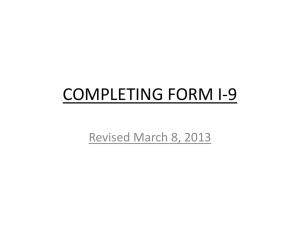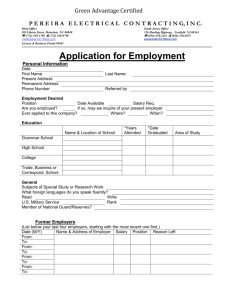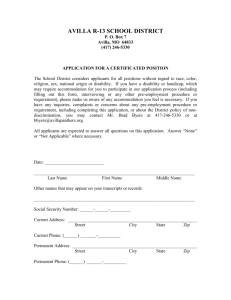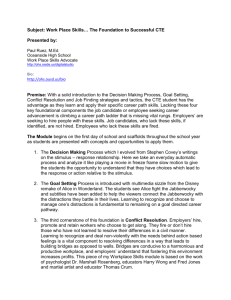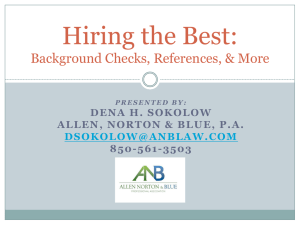to - Florida Association of Court Clerks and Comptrollers
advertisement
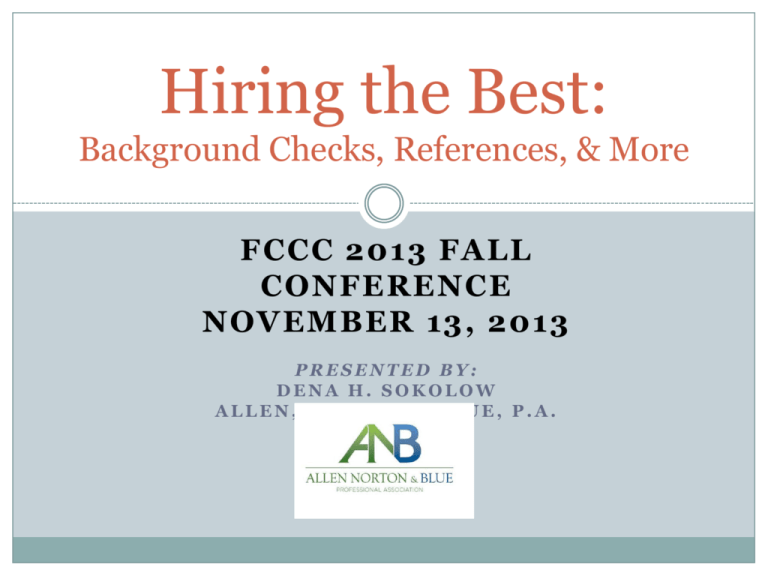
Hiring the Best: Background Checks, References, & More FCCC 2013 FALL CONFERENCE NOVEMBER 13, 2013 PRESENTED BY: DENA H. SOKOLOW ALLEN, NORTON & BLUE, P.A. Employers Should Be Curious You are entitled to learn as much information about a candidate as possible before offering them a position. Well-drafted applications ask: Previous work history Previous work experience Educational background Military background References Employers Should Be Curious You are entitled to learn as much information about a candidate as possible before offering them a position. Acknowledgments and permission Truth and accuracy of information Background checks Military or school records check Background Checks Over 90% of employers conduct criminal background checks for some job applicants. Over 70% of employers conduct background checks on all potential new hires. Identify candidates who display a history of good decision making and judgment. Reduce the risk of criminal behavior in the workplace. Avoid negligent hiring lawsuits. Developments Criminal background checks obtained for employment purposes are controversial. Under attack from: the U.S. Equal Employment Opportunity Commission (EEOC) Civil rights activists President Obama 2012 Enforcement Guidance from EEOC More and More “background check” Lawsuts In 2013, the EEOC lost two high-profile federal lawsuits1 It attempted to show that many employers use criminal and/or credit background checks to discriminate against applicants in violation of Title VII. Courts did not find the EEOC’s statistics persuasive. 1 EEOC v. Freeman; EEOC v. Kaplan Learning. More and More “background check” Lawsuits The EEOC will continue pursuing claims that criminal and/or credit background checks violate Title VII. Employers should review their policies, ensure that screens are job-related, defensible, and based on business necessity. The Free Credit Reporting Act (FCRA) The FCRA regulates the exchange of consumer information between employers that use consumer reporting agencies (CRAs) to provide screening reports with other types of information, including criminal records. Employers must comply with the FCRA when they order virtually any type of report from a CRA. Compliance with the FCRA The FCRA’s requirements on employers may be divided into two categories: (1) requirements employers must follow before they obtain a consumer report (2) requirements employers must follow if they take “adverse action” based on information contained in the consumer report. Obtaining a Report Employers can do a background check on any applicant. In order to obtain a report from a CRA, an employer must get the applicants consent: make a clear and conspicuous written disclosure to the applicant, in a document that consists “solely” of the disclosure, that a consumer report may be obtained. The applicant (or employee) must provide written consent. Obtaining a Report NOTE – A properly worded authorization from an applicant will allow an employer to obtain more consumer reports during employment without the need obtain a new authorization. Now you’ve received the report … What next? If the report doesn’t contain any damaging information – GREAT! If it DOES contain damaging information, you can reject an applicant based on the poor report. This is called “adverse action” and the employer must follow certain requirements. “adverse action” = “a denial of employment or any other decision for employment purposes that adversely affects any current or prospective employee.” Fair Credit Reporting Requirements When taking an adverse action, the employer must -- 1. Disclose to the applicant that you are not selecting him/her because of the poor report. 2. Provide a copy of the consumer report and who provided it to you. 3. Provide a summary of consumer rights (a document provided by the Consumer Financial Protection Bureau). Potential Liability for FCRA Non-Compliance The FCRA allows an applicant or employee to sue an employer for “negligently” or “willfully” failing to comply with any of the FCRA’s requirements. The statute of limitations for violations of the FCRA: (1) two years after the plaintiff discovers the violation; or (2) five years after the date on which the violation that is the basis of the alleged liability occurred. Emergence of FCRA Class-Actions Recently, large employers have lost several class actions because they violated FCRA requirements. Did not provide notice or Did not properly handle documents. As more publicized settlements occur, the risk grows for “copycat” suits brought by plaintiffs’ attorneys not previously familiar with the FCRA. Hiring Decisions Employers must be CONSISTENT with the treatment of applicants. What if you hire the white applicant with poor consumer report and then use similar information as a basis for not hiring a minority applicant. LAWSUIT! Employers are allowed to have different consumer report standards for applicants v. employees. TIP: Employers cannot discriminate (refuse to hire) an applicant simply because he/she filed for bankruptcy. BUT . . . can refuse to hire because of bad credit. Using Background Information Are You Risking a Lawsuit?: Ask Three Questions Question #1 – Is all available information equally relevant in selecting a candidate? Question #2 – Do you have valid reasons to order background checks? Question #3 – Are you making appropriately tailored assessments of unsuitability? Q #1 – Is the information equally relevant? The scope of a background screen can be as narrow as reviewing driving history or as broad as reviewing all information contained in any public and educational record. As you peruse the menu of screening choices you should ask yourself, “What are we going to do with the results?” Q #1 – Is the information equally relevant? Criminal History Before hiring candidates, identify what kind of criminal background information you will look for … Related to honesty (theft, etc.) Including how many years back Employers get sued when there is inconsistency in the type of background check each applicant gets Q #1 – Is the information equally relevant? Ex: Employer refuses to hire a qualified minority with a DUI conviction and then hires a qualified white male with similar DUI conviction. Establishing (1) (2) a policy will: help prevent lawsuits and help defend against them if and when they come CONSISTENCY IS KEY Q #1 – Is the information equally relevant? Credit History Do the same financial background check for all applicants applying for the same job – not just some of them. Use the information for positions with financial risk, i.e. such as accountant, controller, etc. Provide an opportunity for applicants to explain their negative credit-history information. CONSISTENCY IS KEY Q #1 – Is the information equally relevant? Arrest history When a job candidate is arrested for a crime and then not convicted (or only convicted of a less serious crime): both state and federal regulators have warned employers to either ignore this information altogether, or use it merely as a basis to ask an applicant for more detail about the events surrounding the arrest. CONSISTENCY IS KEY Q #2 – Valid reasons for the report? Should you complete a background check for the position? Consider this information : the nature of job duties; the environment where the work is performed; or the exposure to the public Do these factors make it important to be able to evaluate a candidate’s criminal history or current financial position as part of your assessment? Q #2 – Appropriate assessments? Consistency is a critical litmus test of whether there is discrimination in the workplace The greater the consistency, the less likely that discrimination is present. Q #2 – Appropriate assessments? To err on the safe side -- you should place greater emphasis on criminal (or credit) history that makes a candidate unsuitable for a particular job position by considering factors such as: The nature of the job sought; The number, nature and gravity of offense(s), as well as surrounding facts such as age at the time of conviction; Amount of time since the offense and/or completion of the sentence, and any evidence of rehabilitation efforts, employment history, or compelling references. Other Types of Background Checks What if you do not use a consumer reporting agency, such as a Sheriff’s office or the FDLE? Background checks done by non-CRAs are not regulated by the FCRA and its “notice” requirements. Still obtain the applicant’s consent. A well-drafted authorization form will allow you to run background checks on that employee in the future. Reference Checks Ask all you want! Job references Performance/Attitude, etc Previous employment Gaps in employment “Job hoppers” Reasons for leaving the job. “He didn’t get along with the supervisor.” False or Misleading Information What if you unknowingly receive false or misleading information from the applicant and you use it as a reason for non-selection? Entirely permissible. You still must be consistent in what weight you give certain facts. Important to document reference information What if – after you hired the applicant – you discover he provided you false/misleading info? You can terminate the employee. Just be consistent. Warning on application. Public Employees = Public Records Make a public records request from the previous employer if the applicant worked for a public entity. Carefully word the public records request to be as broad as possible. A Few Tips TIP: written consent is required to obtain school transcripts or detailed information on an applicant’s military service record. TIP: Do not place a candidate who does not meet minimum qualifications into the pool of candidates who do meet qualifications. TIP: Carefully review information given on application/resume. Compare Look for gaps A Few Tips TIP: Proofread your own forms! Employment Applications, Contracts and Orientation Materials Immigration Reform and Control Act of 1986 (“IRCA”) Applies to employers with more than 3 employees Prohibits discrimination against any person, other than an unauthorized alien, in hiring, discharging, recruiting, or referring for a fee because of the person’s citizenship status. Unlawful Employment of Aliens It is unlawful for a person or other entity— to hire, or to recruit or refer for a fee, for employment in the United States an alien knowing the alien is an unauthorized alien … with respect to such employment… (8 U.S.C. Section 1324a (A)(1)) Unlawful Employment of Aliens Continuing employment It is unlawful for a person or other entity, after hiring an alien for employment …, to continue to employ the alien in the United States knowing the alien is (or has become) an unauthorized alien with respect to such employment. … (8 U.S.C. Section 1324a (A)(2)) Unlawful Employment of Aliens The term “unauthorized alien” means, with respect to the employment of an alien at a particular time, that the alien is not at that time either: an alien lawfully admitted for permanent residence, or authorized to be so employed by IRCA or by the Attorney General. Citizenship Requirements The purpose of the federal employer sanctions law is to require employers to hire only individuals who may legally work here: U.S. citizens, noncitizen nationals, lawful permanent residents, and aliens authorized to work. Form I-9 helps employers to verify individuals who are authorized to work in the United States. You, as an employer, must complete a Form I-9 for every new employee you hire. I-9 Form Requirements What are the current civil penalties? First fines range from $110 - $1,100 per I-9. Knowingly hiring or continuing to employ: fines range from $375 - $3,200 per alien Pattern or practice: $3,300 - $11,000 I-9 Form Requirements What are the basic Form I-9 requirements? Employers must complete for every new hire. Employers may not knowingly hire or continue to employ a person who is not authorized to work in the United States. Physical presence of the employee is required. Must see original documents, not copies. However will accept a certified copy of birth certificate. No exception for temporary or part-time employment. I-9 Form Requirements How should Form I-9 be completed? Physical presence of employee is required (Someone has to see person and his/her documents) Must see original documents, not copies. However, will accept a certified copy of birth certificate. Attach photocopies of documents. No exception for temporary or part-time employment I-9 Form Requirements When must the Form I-9 be completed? Within three business days of the date employment begins. If the new hire claims that the necessary documents were lost, stolen or destroyed, the person must provide a receipt for replacement documents within the three days. If an employee has presented a receipt for a replacement document, he or she must produce the actual document within 90 days of the date employment begins. I-9 Form Requirements Is completion of an I-9 required for a person who is on leave? No I-9 is needed if an employee is “continuing to be employed.” Leave of absence, disability, vacation, etc. Promotion or demotion Strike, temporarily laid off Disciplinary suspension I-9 Form Requirements Employer’s retention obligations? 3 years from date of hire, or 1 year after the date employment ends Whichever date is later TIP: Keep separate from immigration and personnel files Importance of Compliance Form I-9s now administratively inspected by U.S. Immigration and Customs Enforcement (“ICE”), U. S Department of Labor (“DOL”) Notices of Inspection (“NOIs”) put employers on notice that their employee records (I-9 Forms) will be audited and examined by ICE officials Importance of Compliance The NOIs target employers who employ undocumented workers Audits can result in civil penalties or criminal prosecution Food supply chain companies have been targeted the most, but other industries are also targeted It is expected that this upward trend will continue I-9 Form Requirements Document TIPS U.S. passport CANNOT be expired Foreign passport must be unexpired ID card must be issued by a federal/state/local government agency. Voter’s registration card need not have photo to confirm identity. I-9 Form Requirements Document TIPS For E-Verify candidates, a photo ID is required. Social security card not acceptable for work authorization if it contains notations “Not Valid for Employment.” Social security card will NEVER say “Valid for Employment.” Birth certificate must be issued by state or local government authority. (Not church, not hospital.) FAQs Do I need to complete a Form I-9 for everyone who applies for a job with my company? No. You need to complete Form I-9 only for people you actually hire. For purposes of the I-9 rules, a person is “hired” when he or she begins to work for you for wages or other compensation. FAQs Can I terminate an employee who fails to produce the required documents within three business days? Yes. May terminate an employee who fails to produce the required documents, or a receipt for replacement documents within three business days of the date employment begins. However, be CONSISTENT with all employees. E – Verify E-Verify is an internet-based system offered by the Department of Homeland Security (“DHS”) Allows employers to determine the eligibility of their applicants to work in the United States. Electronically compares an employee’s I-9 Form with government (social security, immigration, DHS) records, and alerts employers if an employee is ineligible to work based on immigration status. E – Verify ALL Florida state agencies required to use E-Verify A recent study found that the system correctly determined a worker's immigration status 96% of the time. However, the program failed to flag unauthorized workers 54% of the time because the system cannot spot identity theft. “No – Match” Letters Issued by the Social Security Administration (SSA) if an employee’s name or social security number on a W-2 form does not match to a valid Social Security number. The SSA calls them “Decentralized Correspondence” (DECOR) letters. It cautions employers against taking adverse action against the employee based solely on receipt of letter. “No – Match” Letters Mismatches could be due to: Misspellings Transposed numbers Name changes False SSNs Identity theft The no-match letter will make no statement about an employee’s immigration status, but the employer MUST respond & proceed cautiously … Have a Plan for “No – Match” 1. Check employment records 2. Respond to the letter Even if the letter says your response is not required, SSA may refer the matter to the IRS or Justice Department for prosecution of Social Security fraud if you ignore the letter. Have a Plan for “No – Match” If you inaccurately recorded the employee’s Social Security Number: 1. rectify the error in the current payroll system; 2. submit a Form W-2c to the SSA reflecting the appropriate data; and 3. complete the SSA questionnaire with accurate data from the employee’s revised personnel file or payroll system. Have a Plan for “No – Match” If you confirm that your internal records accurately reflect the employee’s Social Security Number: 1. provide written notification of the mismatch to the affected active employee, 2. specifying that they have thirty (30) calendar days to correct the mismatch problem. 3. NOTE: Obtaining new Social Security card may take 60 days so provide more time if reasonable verbally notify the affected employee – consistent with the written notice given – that you will use E-Verify to confirm any new Social Security Have a Plan for “No – Match” 4. Complete the SSA questionnaire after giving the affected employee the thirty (30) day period to rectify the mismatch 5. You may terminate the employee for failure to provide a valid social security number if he/she fails to timely remedy the mismatch 6. Then, questionnaire will be completed showing the individual as no longer employed. Have a Plan for “No – Match” Finalizing Documentation In separate immigration file – Not personnel file All documentation used in these communications copy of the completed SSA questionnaire, If necessary, flag former employee’s Social Security Number in the company’s payroll system to prevent future rehire unless he/she has an unresolved Social Security Mismatch letter on file. Hiring Decision on an Impermissible / Illegal Reason Race Title VII and FCHR Pretty self-explanatory – you cannot non-select because of someone’s race Sex Title VII and FCHR Gender is one component Pregnancy – what happens if an applicant says she is pregnant – can you use that as a basis for non-selection? No! Its the same as if they were current employee. Hiring Decision on an Impermissible / Illegal Reason Disability ADA What medically-related questions can you ask before making an offer of employment? Basically nothing. Age ADEA National origin Military status Florida’s Veterans Preference Law Marital Status History of workers‘compensation claims How do these cases get proven? Direct evidence Email is a plaintiff lawyers best friend! For a Clerk of Court it is a public record! Bottom line – DO NOT write anything about race, sex, age, medical condition, national origin, religion, military status, union organizing, worker’s compensation, sexual orientation Inference of discrimination Irregularities of deviation in the process Inter-Office Memoranda and Emails Develop and implement policies concerning the use and scope of inter-office memoranda and emails A 2004 study revealed that 35% of businesses had an email retention policy, and only 6% retained and archived instant-messaging records 54% of businesses had conducted training on proper email use Inter-Office Memoranda and Emails Intemperate remarks in either memos or emails can be a catalyst for a costly lawsuit In the same study, 20% of businesses stated they had employee emails subpoenaed , a steady increase from preceding years Employees and supervisors should avoid private matters or inflammatory subjects in their written or electronic communications Emails may become public records; if private, may still be discoverable in a lawsuit. Guidelines for Public Employers Public Records The general rule - unless the Legislature has expressly exempted certain records from disclosure those records are subject to public inspection and copying Background Information. Applies to all types of records including letters, notes and e-mails. Supervisory notes or files Draft copies? Personnel files Useful Examples Some Public Records Exceptions Sexual harassment investigations - portions of the records that identify or reasonably could lead to the identification of the complainant or a witness constitute limited-access records. “Uncirculated drafts” Employee medical information All documentation relative to why employee’s explanation of positive drug test results is unsatisfactory, along with the report of the positive test results, are confidential and exempt. Useful Examples Retention Schedule for Public Records Public agencies/employers are required to retain public records according to a retention schedule established by the Florida Department of State The schedule can be found at: http://dlis.dos.state.fl.us/recordsmgmt/gen_records_sche dules.cfm Thank You ANY QUESTIONS, CONTACT ME AT: 906 NORTH MONROE STREET TALLAHASSEE, FL 32303 (850) 561-3503 DSOKOLOW@ANBLAW.COM THIS PRESENTATION IS NOT INTENDED AS A SUBSTITUTE FOR INDEPENDENT LEGAL ADVICE.
